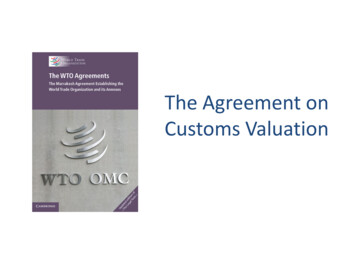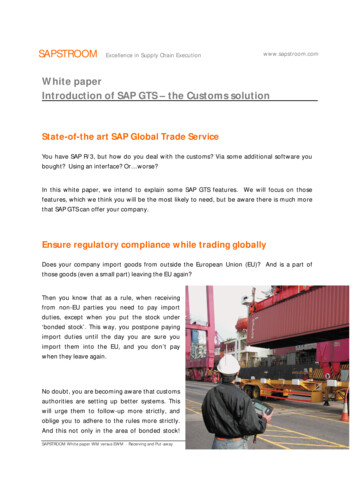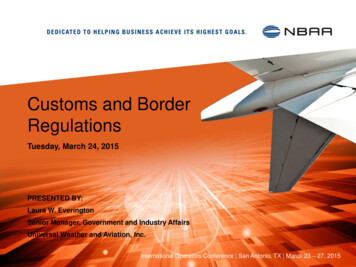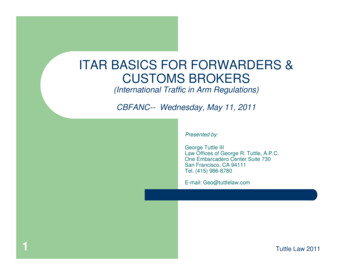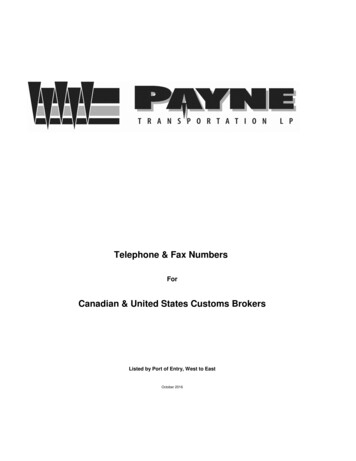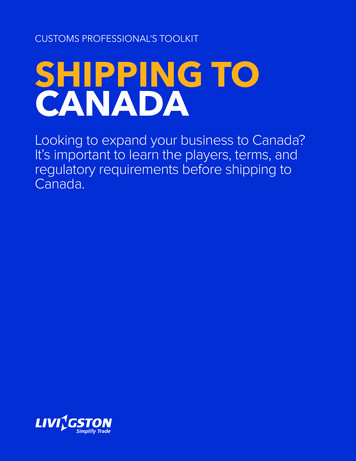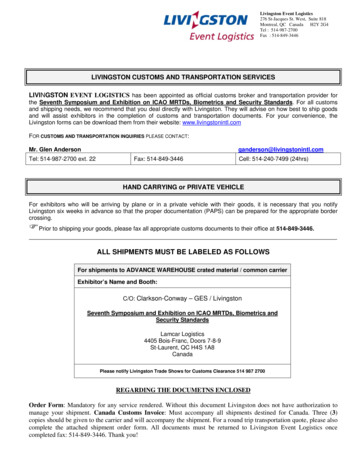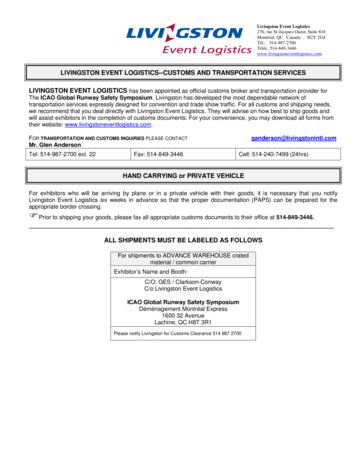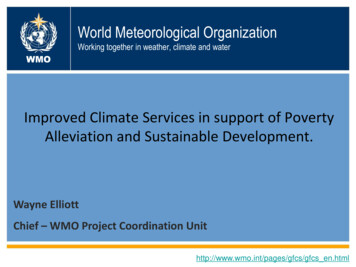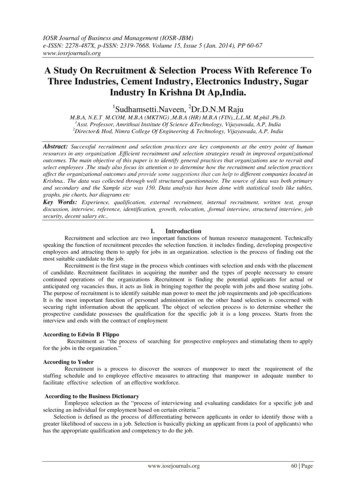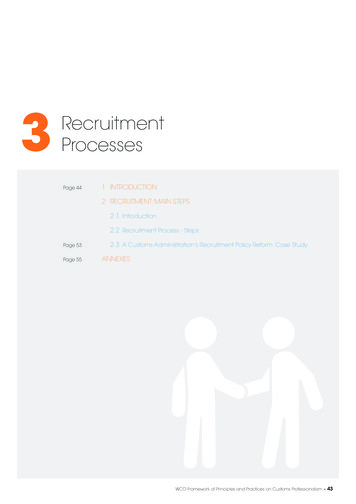
Transcription
3RecruitmentProcessesPage 441. Introduction2. RECRUITMENT: MAIN STEPS2.1. Introduction2.2. Recruitment Process - StepsPage 53Page 552.3. A Customs Administration’s Recruitment Policy Reform: Case StudyANNEXESWCO Framework of Principles and Practices on Customs Professionalism43
3RecruitmentProcesses1. INTRODUCTIONWhen an organization needs clarity on the type of employeesor competencies it currently needs and those it will need inthe near future, it is advisable to have solid staffing policieswhich respond to these needs. Recruiting and retaining theright employees or competencies can be done in variousways. A decision can be made to develop the competenciesof current staff or to recruit the required competencies fromthe labour market. Recruitment can hence be made internally(promotion of internal staff) or externally (acquire staff fromthe labour market). While there may be some proceduraldifferences between internal and external recruitment, the“recruitment process” itself can be dichotomized in steps thatcould apply to both types of recruitment.Recruitment methods by Members can be divided into twotypes: the first is regular or periodic recruitment from thelabour market based on examination by the government orCustoms administration and the second is vacancy-basedrecruitment. Vacancy-based recruitment is also classified intotwo types: recruitment from internal resources (promotionof internal staff) and from the external market (acquire stafffrom the labour market). There may be some proceduraldifferences between internal and external recruitment; thebasic steps/processes, however, are the same and couldapply to both internal and external recruitment methods. Thissection of the compendium focuses solely on the vacancybased recruitment process, which are widely applied to bothpromotion and recruitmentOrganizations occasionally need to recruit in order to add, tomaintain, or to readjust their work forces in accordance withHR-requirements. Organizations as open systems demandthis dynamic equilibrium for their maintenance, survival,and growth. They want to be as attractive as possible, buton the other hand it wants to make the right choice from thepotential employees.When the need to hire new staff arises, a methodologicaland structured recruitment process will support Customsadministrations in selecting the best suited job applicant.The recruitment, selection and induction checklist (Annex 1)might be very useful and also refers to a number of otherAnnexes for further information.One recognized tool to support the recruitment of newpersonnel is a “staffing plan/policy”. A well designed andresearched “staffing plan/policy” indeed supports anorganization in identifying its workforce needs and to thenundertake the recruitment of the “needed” staff. A properly44World Customs Organizationfunctioning recruitment system offers the opportunity to selectthe right people for the right job. The purpose is to provideCustoms administrations with the required competencies,taking into consideration both short-term and long-termplanning. Because recruiting new staff often involves largeinvestment, it is important that the candidate fits into theorganization not only now, but also in the future. On mostoccasions it is not easy to predict how a new employee willdevelop over time. However, some practical recruitment toolscan be used to deal with such unpredictability. A set of toolsis presented in the following pages. They will be updated inthe future through the collection of supplementary practicesfrom the WCO Members.2. RECRUITMENT: MAIN STEPS2.1. IntroductionThe section below is meant to give an overview of the mainsteps to take into account when recruiting (internally orexternally) new staff members. It can be used: As a general guideline when recruiting people; As a starting basis to develop a recruitment procedure; or To revise an existing recruitment procedure.2.2. Recruitment Process - StepsThis recruitment process assumes that the organization hasrecruitment under own management and control.When this is not the case, it is important to analyze anddiscuss internally to what extent the HR division could bemore involved in future recruitment activities in which staff ishired for the organization. This is important to ensure that theright people with the right skills, knowledge and experienceare hired for the functions to be filled in, and to avoid thatunskilled people are appointed or that people are hired forthe wrong reasons (e.g. political appointments.).
3. Recruitment ProcessesStep 1Identify workforce needsand developa staffingplanStep 2Obtainauthorisationto recruitStep 3Advertisingthe postStep 4Step 5Step 6Step 7Step 8Compositionof theselectionpanelSelectcandidatesfor interview& identifyany tests orpresentationsThe selectioninterviewAppoint Step 1: Identify Work Force Needs and Develop aStaffing PlanThe first step to ensure that the recruitment of new staff isrelevant to the organization is to carry out a workforce needs& gaps analysis based on the strategic plan and missionobjectives of the organization. This analysis should be usedas the cornerstone document to develop the organizationstaffing plan. In turn, the staffing plan and workforce needsand gaps analysis are the key resource documents used byan organization to develop new job descriptions or updateexisting ones.Staffing Plan:The Staffing Plan defines the required human resourcesneeded to deliver the desired objectives. The Staffing Planmust provide the appropriate skill sets to perform the tasks/activities that produce the specified outputs/deliverables. Singapore Customs administration6 Steps Workforce Gap Analysis Step 1: Review the CA’s strategic direction and plan. Step 2: Scanning of internal and external environment. Step 3:Projectionrequirements. Step 4:Development of workforce gap closingstrategies.offutureworkforceneedsThe Singapore CA, with a continuous improvement frameof mind, also follows up on their gap analysis and gapclosing strategies with the following 2 steps: Step 5: Implementation of gap closing strategies,including communication with affected stakeholderson the strategies. Step 6: Monitoring and Evaluation of the gap closingstrategies.Why is this important?It’s important for an organization to accomplish itsobjectives as efficiently as possible.This requires a skilful andinsightful allocation of resources. Once an organization ordepartment’s scope is defined, the management decisionsrelating to resource assignments are important factors inensuring the completion of the stated objectives.The Customs administrations of Singapore, Jordan andBulgaria, have developed a thorough methodology toidentify their workforce needs, which are showcased in thefollowing boxes.Jordan Customs administrationFactors used to perform the Workforce Gap Analysis Factor 1: Human Resources requirements linked to theimplementation and achievement of the strategic planand mission objectives. Factor 2: Staff fluctuations elements such as- Attrition rate (deaths, retirement, resignation,.);- Staff rotation (promotions, secondment.)- Maternity and prolonged sick leave. Factor 3: Administrative units express their needs andrequirements annually and they are taken into accountwhen performing the workforce gap analysis.The analysis methodology and outputs (workforce gappredictions.) are monitored and evaluated annually toensure accuracy of future workforce gap analysis.WCO Framework of Principles and Practices on Customs Professionalism45
The Bulgarian Customs administration, in addition tothe factors mentioned above and used by the JordanCustoms Administration, also lists changes in legislationand the introduction of new technical facilities and workmethods as factors taken into account when performingtheir own workforce gap analysis.These factors are, indeed,worth mentioning here. Have the approval and support of the key staff within theorganization prior to seeking external authorization torecruit.This authorization, also, ensures that the necessary resources(human, financial and material) will be made available toconduct the recruitment and to hire the staff needed.Step 3: Advertise the PostStep 2: Obtain Authorisation to RecruitOnce the workforce needs and gap analysis has beenperformed and the staffing plan has been developed, it isimportant to ensure that the top/line management approvethem. Indeed, their approval will be necessary to obtain theauthorisation to recruit. Depending on the organizationalchart and interpendencies with other governmental services,an organization may have to seek to authorization to recruitfrom an external body. It is, hence, very important to: Develop a “sound” staffing plan together with acommunication strategy in place to present it convincinglyto the relevant decision-makers; andAn organization has to decide whether it will recruit internallyor externally. This decision will determine the means used toadvertize the vacancies.The effective use of ‘in-house’ talent should, ideally, comefirst. If an organization undertakes external recruitment effortswithout considering the desires, capabilities, and potentialof existing employees, it may incur both short and long-termcosts. However, there are some possible downsides of internalrecruitment that have to be taken into account. The pros andcons are clarified in the following table.The Pros and Cons of Internal RecruitmentProsConsLower costsProcedure less formal and objectiveQuicker proceduresCreation of new job openingsBetter capable of making judgementsemployment in new functionabout futurePossible frustration due to rejection or competitionChance of ‘inbreeding’, corporate blindnessQuicker socialisation processSupports career developmentMotivates, retains staff46World Customs OrganizationThe Peter Principle: employees are promoted to the pointwhere they are no longer capable of fulfilling the function;promoted to a point of incompetence.
3. Recruitment ProcessesEffective means to communicate vacancies internallyinclude, for example:Effective means to communicate vacancies externallyinclude, for example: Posting in in-house magasines or newsletters, Media campaigns, Posting on the internal network webpage; Specific personnel advertisements in professionalmagazines and on national and regional newspapers; Diffusion of the job vacancies through circulars andemails to the staff. Own public Website and professional websites; Inform their own network; Use external parties like recruitment agencies.Please refer to Annex 3 to see an example of a Job applicationform for internal candidates.Before an organization decides to recruit externally, therecould be an intermediate phase. Indeed, organizationsoften have ‘recruitment reserves’. These reserves consistof previous applicants that have been refused in earlierprocesses or those who have submitted open applications atsome other time. This group is a relatively inexpensive groupto communicate the vacancies to and therefore may beworthwhile considering before ‘going public’.When selecting one of these options, the following questionshould be kept in mind: What is the organization’s eventualtarget group? The more scarce the target group, the morespecific the recruitment and job posting must be.When posting a job vacancy, it is important to advertise aclear job description (see section on job descriptions), clearinstructions on how to apply for the vacant position as wellas clear selection criteria. The following structure of the posterfrom the Canadian Border Services Agency (CBSA) is agood example of job poster structure. The full CBSA poster isavailable in Annex 6.When the organization does decide to take on externalrecruitment, a medium must be selected in order to reachthe possible employees.CBSA Officer Trainee – Job Posting StructureIntroductionShort presentation of the CBSA missionsPreliminary List ofMinimum Requirements:Listing of minimum requirement in bullet points onlyVacancyInformation:Name of Recruiting Agency (CBSA)Job Posting LocationJob Classification/Grade (gives the grade and refers to link for more information aboutthe grade)Salary ScaleDeadline for ApplicationReference Number:Selection Process Number:Employment Tenure: (length of contract)Vacancies: Number of VacanciesWebsite reference for more information about the positionEligibility Criteria:Detailed information about minimum eligibility criteriaAsset Criteria:Detailed information about “asset criteria”, candidates also fulfilling one, various or allof these criteria will be given preference over the candidates meeting only the eligibilitycriteriaOperational Criteria:Mandatory operational criteria to be met by applicantsConditions ofEmployment:Conditions to meet and agree to before and during employmentWCO Framework of Principles and Practices on Customs Professionalism47
Information about the physical and mental challenge of the positionSelection Process:Information about the selection procedure and conditionsInformation to be provided when applyingImportant information:Information about how to applyInformation about feedback to applicantsInformation to applicants with disabilitiesThank you note to applicantsCBSA commitments to conduct a fair, meritocratic and transparent recruitment process.Words of encouragement for women and members of ethnic minorities to apply.Step 4: Composition of the Selection PanelDepending on the function to be filled in and the purpose ofthe selection panel (e.g. first CV screening, interview panel,final selection committee), different selection panels can becomposed.To comply with best practice in equal opportunities, panelsshould reflect an appropriate mix of gender and ethnicity.The box below provides an interesting example from theBotswana Unified Revenue Service as it presents the structureof appointment and promotions committees.Botswana Unified Revenue Service – Structure of Ap
“recruitment process” itself can be dichotomized in steps that could apply to both types of recruitment. Recruitment methods by Members can be divided into two types: the first is regular or periodic recruitment from the labour market based on examination by the government or Customs administration and the second is vacancy-based recruitment. Vacancy-based recruitment is also classified into


